全文HTML
--> --> -->对于溶液加工型的多层WOLED, 溶液制备电子传输层的过程, 必然部分溶解下方的发光层, 使器件的发光性能降低. 因此在溶液加工的过程中保持住发光层的发光性能是制备高性能器件的关键[4,5]. 为了保护发光层不受溶液制备电子传输层的破坏, 一方面通常采用甲醇、乙醇或者乙醇/水等正交溶剂, 结合溶解性好、电子传输性能强的有机电子传输材料, 如TPBi (1, 3, 5-Tris(1-phenyl-1H-benzimidazol-2-yl)benzene)制备电子传输层[6-8]. 另一方面, 则采用聚合物主体材料, 如PVK (polyvinylcarbazole), 制备发光层, 因为这类聚合物在退火过程中形成的分子链之间的缠结可以抵挡电子传输层溶剂的清洗, 从而保持发光层的发光性能[9,10]. 但是, PVK作为主体材料也有一些不足之处, 比如, 三线态能级(ET = 2.5 eV) 较低, 无法向蓝光激子提供有效的能量转移; 空穴传输性较强, 导致激子在界面聚集引起激子淬灭[11].
金属纳米粒子在受到外部电磁场激发的条件下, 其表面的自由电荷与电磁场之间能产生耦合作用. 当电磁波的波长满足自由电荷形成集体振荡的条件时, 将发生共振吸收, 使金属纳米粒子表面的电场显著增强, 这种现象称为局域表面等离子体共振(localized surface plasmon resonance, LSPR)效应 [12,13]. LSPR效应可以增强金属纳米粒子周围电场强度, 从而改变附近激子的辐射或电荷的传输, 因此被广泛地应用于各类有机、无机及钙钛矿发光二极管中提升器件性能 [14-17]. 在有机发光二极管中, 比较常用的空穴注入层PEDOT:PSS (poly (styrene sulfonic acid)-doped poly (3, 4-ethylenedioxythiophene)通常采用溶液加工的方法制备, 既易与液相法制备的金属纳米粒子结合, 又与发光层相邻, 因此金属纳米粒子常被引入空穴注入层(hole injection layer, HIL)中改善器件性能[18]. 然而, 对于基于PVK主体的溶液加工型的有机发光二极管, PVK的单极空穴传输特性使激子主要在发光层(emission layer, EML)/电子传输层(electron transporting layer, ETL)界面附近形成并复合, 距离空穴注入层较远. 因此掺入HTL的金属纳米粒子与激子之间的相互作用比较弱, 对器件性能的改善效果并不好.
本文将二氧化硅包裹的银纳米立方(Ag@SiO2 NCs)掺入基于PVK主体的多层溶液加工WOLED的ETL中. 银纳米立方由于具有比较尖锐的形状, 所以有很强的LSPR效应, 能够增强附近激子的辐射强度, 从而提升有机发光二极管的性能[19]. 将Ag@SiO2 NCs掺入ETL, 使其与位于EML/ETL界面附近的激子之间的距离较近, 能够更加有效地增强激子的辐射. 通过对ETL中Ag@SiO2 NCs浓度的优化, 多层溶液加工WOLED的最大亮度达到19427 cd/m2, 最高电流效率达到30.0 cd/A, 是未加入Ag@SiO2 NCs的基础器件效率的2倍.
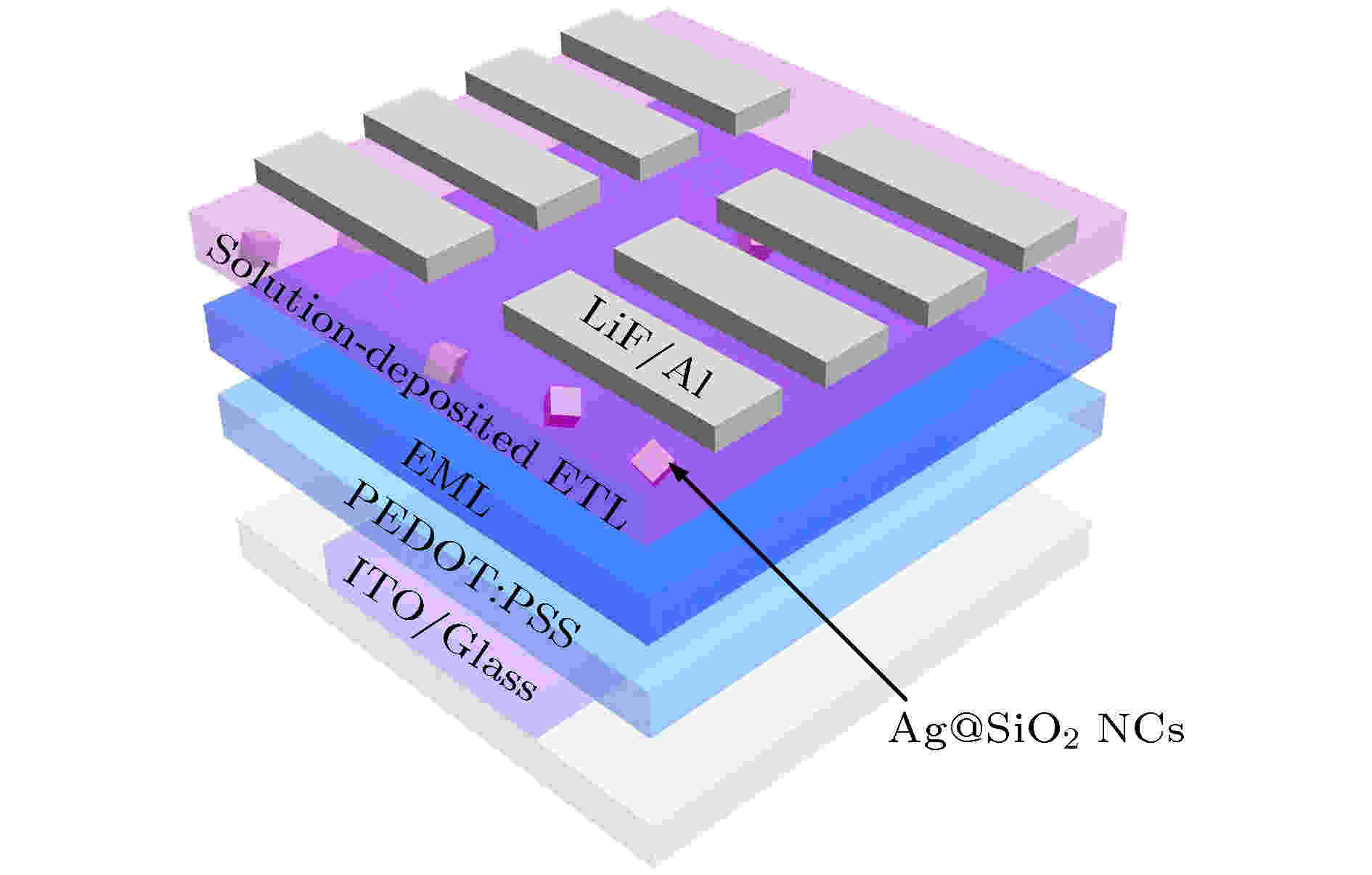 图 1 电子传输层中掺有Ag@SiO2 NCs的WOLED器件结构示意图
图 1 电子传输层中掺有Ag@SiO2 NCs的WOLED器件结构示意图Figure1. Schematic structure of the WOLED with Ag@SiO2 NCs doped in ETL.
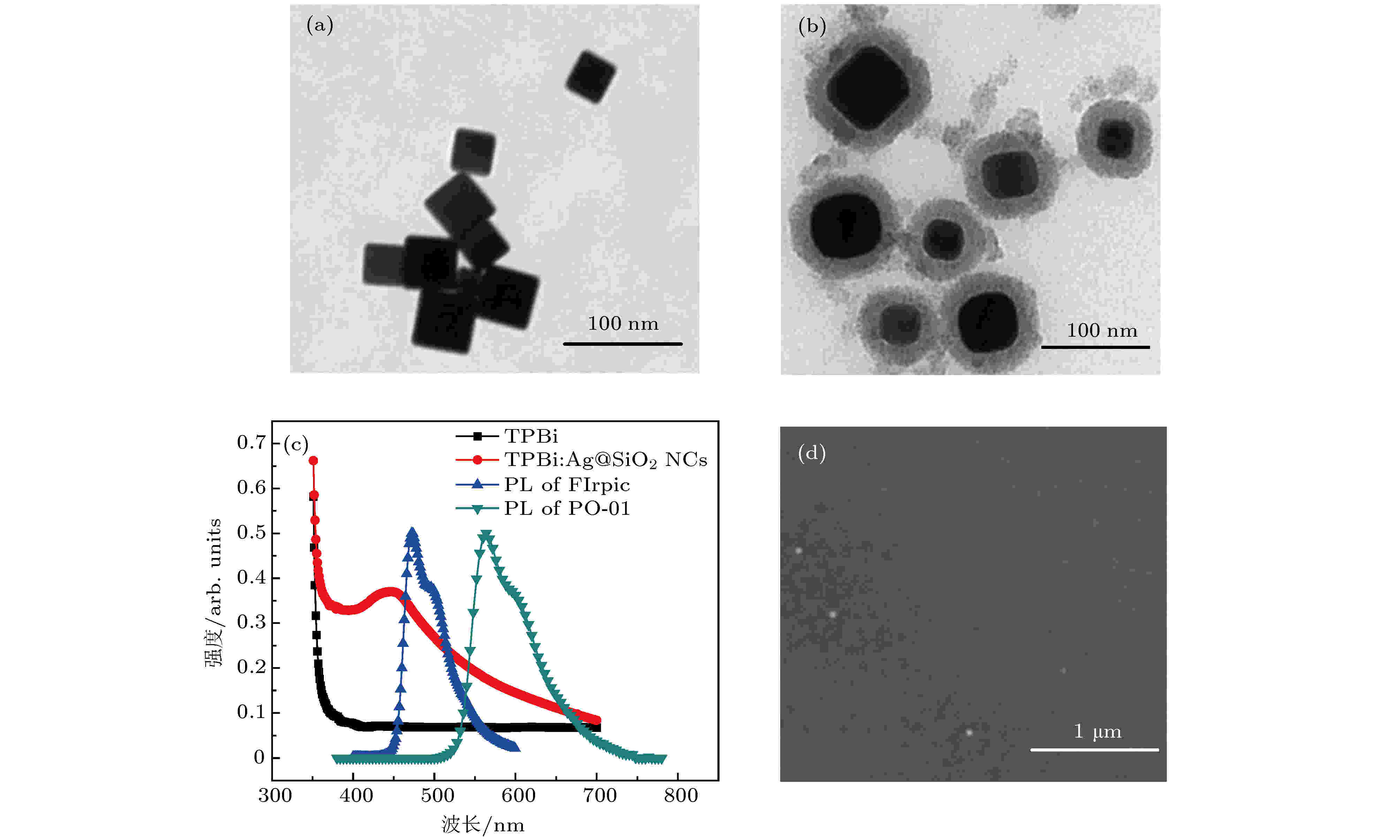 图 2 (a)银纳米立方和(b) Ag@SiO2 NCs的TEM图像; (c) TPBi和掺有Ag@SiO2 NCs的TPBi的吸收光谱, 以及FIrpic和PO-01的PL光谱; (d)掺有Ag@SiO2 NCs的TPBi表面的SEM图像
图 2 (a)银纳米立方和(b) Ag@SiO2 NCs的TEM图像; (c) TPBi和掺有Ag@SiO2 NCs的TPBi的吸收光谱, 以及FIrpic和PO-01的PL光谱; (d)掺有Ag@SiO2 NCs的TPBi表面的SEM图像Figure2. TEM images of (a) Ag NCs and (b) Ag@SiO2 NCs; (c) Absorption spectra of TPBi and TPBi:Ag@SiO2 NCs, and PL spectra of FIrpic and PO-01; (d) SEM image of the surface of ETL doped with Ag@SiO2 NCs.
图3(a)给出一组WOLED的亮度-电压关系曲线, 其中ETL中掺有Ag@SiO2 NCs的器件, 掺杂浓度分别为1%, 1.5%和 2%, 而未掺杂Ag@SiO2 NCs的器件为基础器件. 由于采用溶液加工方式, 器件结构比较简单, 器件中电子和空穴的注入势垒比较高, 所以器件整体启亮电压偏高, 普遍在5—6 V之间. 但是从图中可以看到, 掺有Ag@SiO2 NCs的WOLED, 亮度明显高于基础器件. 当Ag@SiO2 NCs掺杂浓度为1.5%时, 器件的亮度达到最大值19427 cd/m2. 从图3(b)的电流密度-电压关系图可以看出, Ag@SiO2 NCs的掺入使器件电流略有增大, 但远小于其对器件亮度的提升. 由于Ag@SiO2 NCs的掺入大幅提升了器件亮度而对器件电流影响较小, 因此掺入Ag@SiO2 NCs后的WOLED的器件效率明显提高. 当Ag@SiO2 NCs掺杂浓度为1.5%时, WOLED的电流密度达到30.0 cd/A, 为基础器件的2倍, 表现出十分明显的效果. 图3(d)给出了这组器件的归一化电致发光(electroluminescence, EL)光谱, 可以看到银纳米立方的掺入基本没有影响器件光谱. 插图为银纳米立方浓度1.5%的优化器件在不同电压下的归一化EL光谱, 光谱基本不随电压变化, 可见掺入Ag@SiO2 NCs后, WOLED仍然表现出出色的色度稳定性.
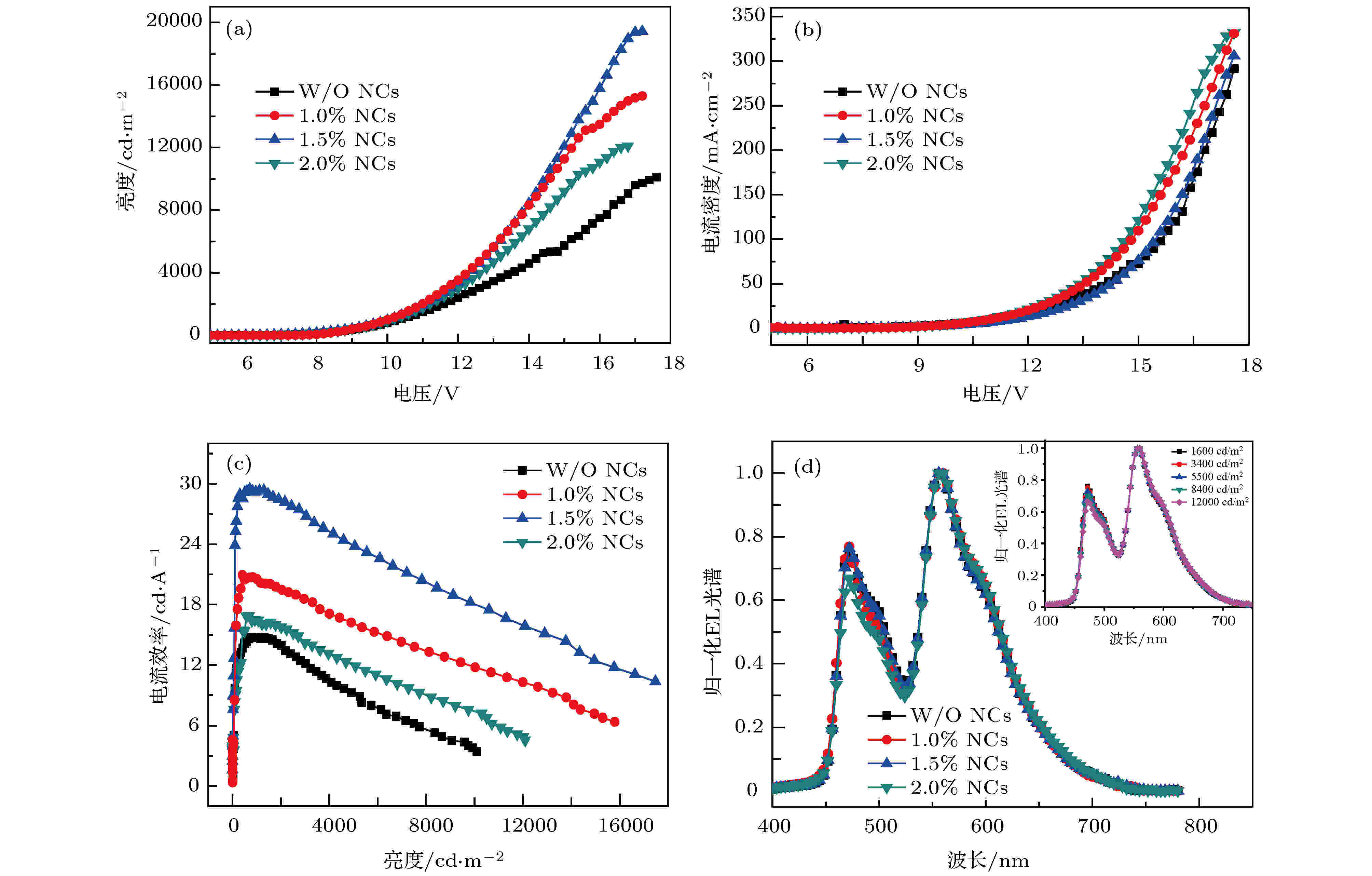 图 3 掺有1%, 1.5%, 2% Ag@SiO2 NCs 的WOLED以及基础器件的光电性能 (a)亮度-电压; (b)电流密度-电压; (c)电流效率-亮度; (d)归一化光谱. 图(d)中的插图为掺有1.5%Ag@SiO2 NCs 的WOLED在不同电压下的归一化光谱
图 3 掺有1%, 1.5%, 2% Ag@SiO2 NCs 的WOLED以及基础器件的光电性能 (a)亮度-电压; (b)电流密度-电压; (c)电流效率-亮度; (d)归一化光谱. 图(d)中的插图为掺有1.5%Ag@SiO2 NCs 的WOLED在不同电压下的归一化光谱Figure3. (a) Luminance-voltage, (b) current density-voltage, (c) efficiency-luminance properties and (d) normalized electroluminescent spectra of the WOLEDs with 1%, 1.5%, 2% Ag@SiO2 NCs and the control device. The inset of Fig. (d) is the normalized electroluminescent spectra of the WOLED with 1.5% Ag@SiO2 NCs at different luminance.
为了研究Ag@SiO2 NCs提升器件性能的工作机理, 我们从光学和电学效应两方面作进一步的表征. 首先, 测量了一组样品的PL光谱. 样品结构为: ITO/PEDOT:PSS (45 nm)/EML (50 nm)/ETL (45 nm): Ag@ SiO2 NCs, 其中电子传输层中的Ag@SiO2 NCs的掺杂浓度分别为1%, 1.5%和2%, 另有一个未掺有Ag@SiO2 NCs的样品作为对比. 图4(a)为这组样品的PL光谱, 可以看出掺入银Ag@SiO2 NCs后, 蓝光和黄光的峰位相对于未掺杂的对比样品均未发生偏移, 说明银纳米立方未改变激子的辐射机制. 同时, 我们看到掺入的银纳米立方的浓度明显影响着激子的辐射强度. 随着银纳米立方的掺入, 且浓度从1%增加到1.5%, PL强度不断增强, 但是当浓度继续增加到2%, PL强度则明显减弱, 显然1%浓度的银纳米立方不能产生足够的等离子体共振, 而2%浓度的银纳米立方产生的LSPR过强引起了激子淬灭. 因此对于本文的WOLED, 1.5%的Ag@SiO2 NCs能够实现最强的LSPR效应. 此外, 我们可以看到Ag@SiO2 NCs同时增强了蓝光和黄光的强度, 这一点与图2(c)中Ag@SiO2 NCs的吸收谱同时覆盖蓝光和黄光的PL光谱相对应, 说明Ag@SiO2 NCs掺入有机材料中之后, 在较宽的波长范围内实现了LSPR共振增强. 从图4(b)的归一化PL光谱同样可以看到, 掺有1%和1.5%Ag@SiO2 NCs样品的PL光谱, 其蓝光和黄光的相对强度与未掺Ag@SiO2 NCs的对比样品基本一致. 但是 2%浓度的银纳米立方对蓝光激子的淬灭更严重, 说明银纳米立方与蓝光激子之间的作用较强, 因此在高浓度下发生了淬灭. 此外, 纳米立方对PL光谱与EL光谱的影响基本相同, 包括2%浓度的银纳米立方对发光激子的淬灭现象, 证明了银纳米立方的等离子体共振效应是导致WOLED性能变化的主要因素.
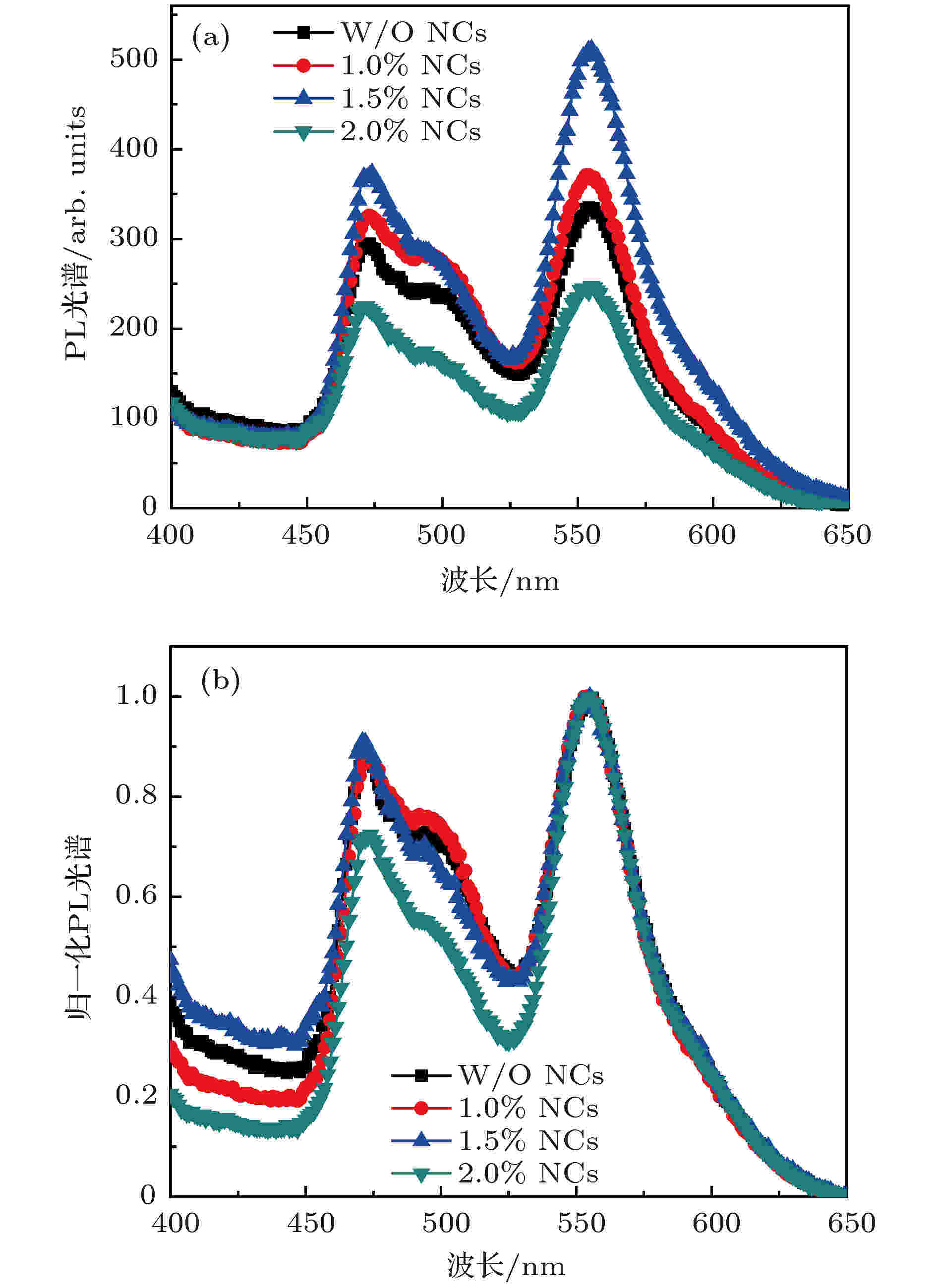 图 4 (a)未归一化和(b)归一化的PL光谱. 样品结构为: ITO/PEDOT:PSS (45 nm)/EML (50 nm)/ETL (45 nm): Ag@SiO2 NCs, 其中Ag@SiO2 NCs浓度为1%, 1.5% and 2%
图 4 (a)未归一化和(b)归一化的PL光谱. 样品结构为: ITO/PEDOT:PSS (45 nm)/EML (50 nm)/ETL (45 nm): Ag@SiO2 NCs, 其中Ag@SiO2 NCs浓度为1%, 1.5% and 2%Figure4. (a) PL spectra and (b) normalized PL spectra of the samples of ITO/PEDOT:PSS (45 nm)/EML (50 nm)/ETL (45 nm) doped with 1%, 1.5% and 2% Ag@SiO2 NCs and the control sample without NCs.
图3(b)中, 银纳米立方使WOLED的电流密度略有提升, 为了研究这种提升是否与等离子体共振效应有关, 我们制备了一组单电子器件, 并测试其电流密度-电压关系. 单电子器件的结构为: ITO/TPBi:TmPyPB (45 nm)/PVK:OXD-7:15wt.% FIrpic:0.5% PO-01 (50 nm)/TPBi:TmPyPB (45 nm)/Al (100 nm), 将1%, 1.5% 和 3%的Ag@SiO2 NCs掺入电子传输层中. 从图5中的电流密度-电压关系曲线可以看出, 纳米立方的掺入同样使单电子器件的电流密度有所提升. 由于单电子器件中不存在等离子体共振效应, 因此电流的提升与等离子体共振效应无关, 可能是由于纳米粒子增加了电子传输层的表面粗糙度而引起少量的漏电流[21,22]. 其中, 掺入3%高浓度的银纳米立方后, 单电子器件的电流显著提升, 进一步验证了掺入银纳米立方引起的表面粗糙度增加对器件中的电流密度有重要的影响作用.
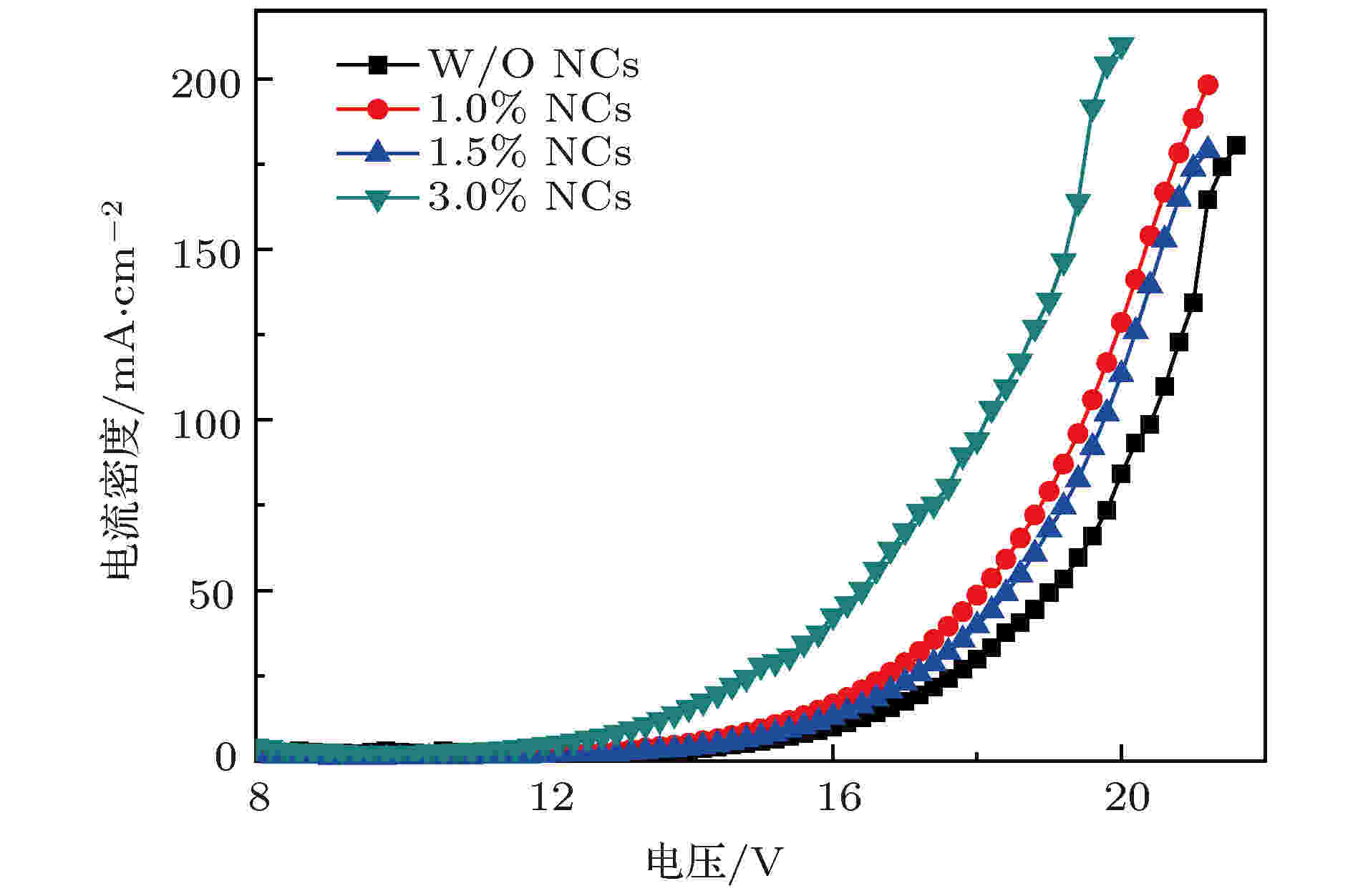 图 5 单电子器件的电流密度-电压关系
图 5 单电子器件的电流密度-电压关系Figure5. Current density-voltage property of the electron-only devices.
在基于空穴型主体材料PVK的WOLED中, 激子主要在发光层/电子传输层界面附近复合发光, 因此位于电子传输层中的银纳米粒子能够更好地与激子发生等离子体共振耦合. 为了进一步说明这一工作机理, 我们将1.5%的银纳米立方分别掺入空穴注入层, 电子传输层, 以及同时掺入空穴注入和电子传输层, 并将三种不同的器件分别命名为H-WOLED, E-WOLED和H&E-WOLED. 除了纳米立方的掺入位置有所调整, 器件结构与前文中的溶液加工型WOLED的结构相同. 图6(a)给出了这组器件的电流密度随工作电压的变化关系, 从图中可以看出, 银纳米立方被二氧化硅包裹后, 对器件电流密度的影响总体较小, 其中掺入空穴注入层的银纳米立方所引起的电流增大相对明显. 从图6(b)的亮度-电压关系图可以看到, 掺入空穴注入层和电子传输层的银纳米立方均能有效提高器件的发光强度, 其中, 电子传输层中掺入银纳米立方的E-WOLED在相同的电压下获得了最高亮度. 显然, 银纳米立方掺入电子传输层后, 一方面可以更加有效地与激子发生耦合提高激子的辐射效率, 另一方面并不引起很大的漏电流, 因此对器件电流效率的提升效果明显优于将银纳米立方掺入空穴注入层这种传统的掺入方式, 如图6(c)中的电流效率-亮度曲线所示. 另外, 还可以看到尽管将银纳米立方分别掺入空穴注入层和电子传输层都能提高器件性能, 但是同时在空穴注入层和电子传输层中掺入银纳米立方的H&E-WOLED器件, 其效率并未得到进一步提升, 且在高亮度下, 表现出严重的效率滚降. 表1中列出了本文中所讨论的WOLED器件的性能. 由于基础器件和银纳米立方浓度为1.5%的器件在图3和图6对应的实验中获得了两组趋势一致、数值略有差异的数据, 因此我们在表1中分别列出两组实验中的数据.
| WOLED | Max Luminance/cd·m–2 | Max Current Efficiency/cd·A–1 | Max Power Efficiency/lm·W–1 | Current Efficiency Enhancement/% | Power Efficiency Enhancement/% |
| W/O NCs | 10091 | 14.7/14.1 a | 8.5/7.7 a | — | — |
| 1% NCs in ETL | 15293 | 20.7 | 13.3 | 40.8 b | 56.5 b |
| 1.5% NCs in ETL | 19427 | 30.0/26.3 a | 18.3/16.5 a | 104.1/86.5 a | 115.3/114.3 a |
| 2% NCs in ETL | 12091 | 16.9 | 11.1 | 15.0 b | 30.6 b |
| 1.5% NCs in HIL | 16545 | 17.6 | 11.5 | 24.8 c | 49.4 c |
| 1.5% NCs in HIL&ETL | 11879 | 19.2 | 17.7 | 36.9 c | 129.9 c |
| a 图3中的器件效率或效率增强幅度/图6中的器件效率或效率增强幅度; b 相对于图3中基础器件的效率增强幅度; c 相对于图6中基础器件的效率增强幅度. | |||||
表1WOLED器件的光电性能
Table1.Summary of the optoelectrical performances of the WOLEDs.
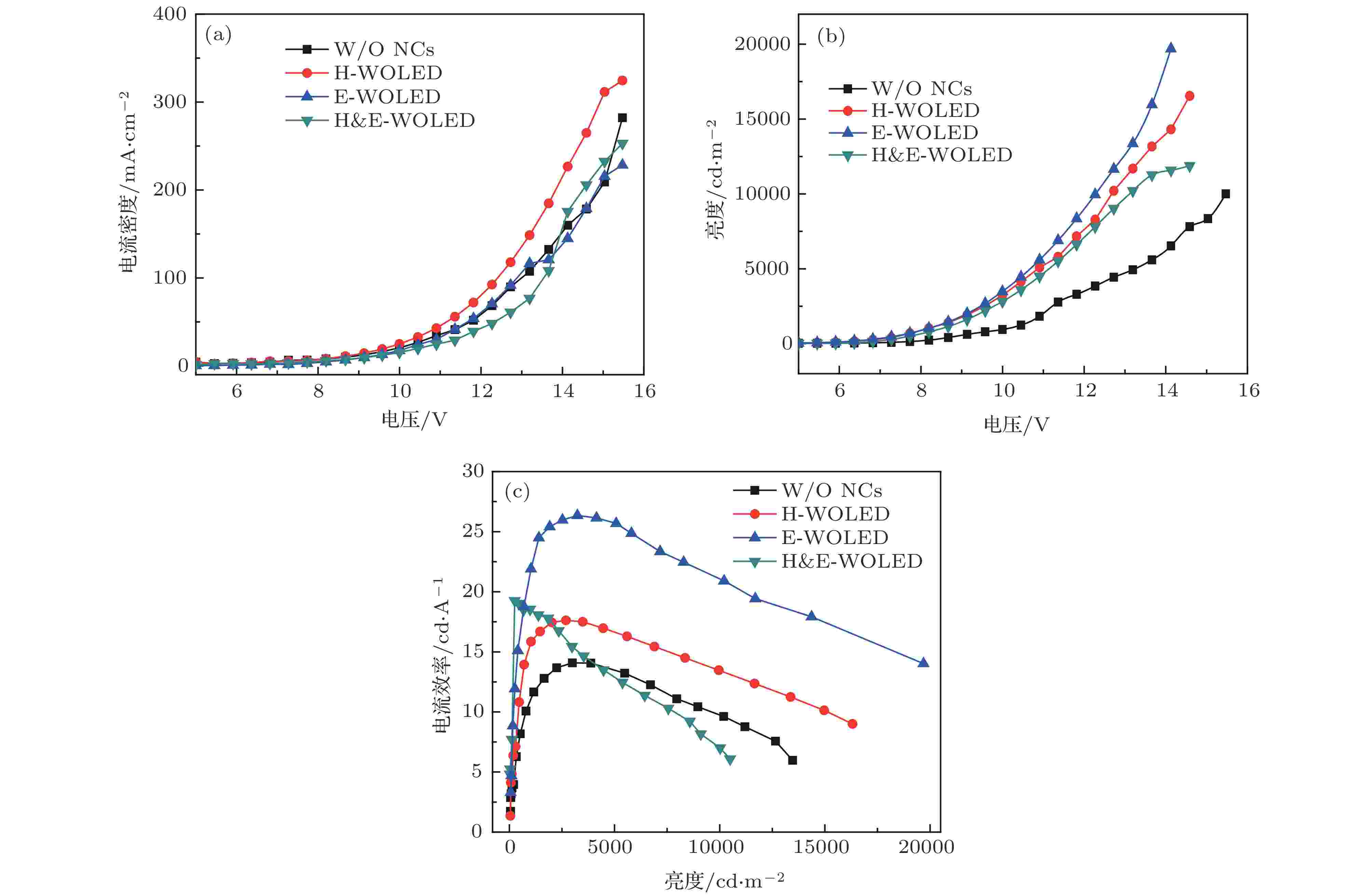 图 6 在WOLED中不同位置掺入Ag@SiO2 NCs后的器件性能 (a)电流密度-电压关系; (b) 亮度-电压关系; (c)电流效率-亮度关系
图 6 在WOLED中不同位置掺入Ag@SiO2 NCs后的器件性能 (a)电流密度-电压关系; (b) 亮度-电压关系; (c)电流效率-亮度关系Figure6. (a) Current density-voltage, (b) luminance-voltage and (c) current efficiency-luminance properties of the WOLEDs with Ag@SiO2 NCs doped in different layers and the control device without Ag@SiO2 NCs.
